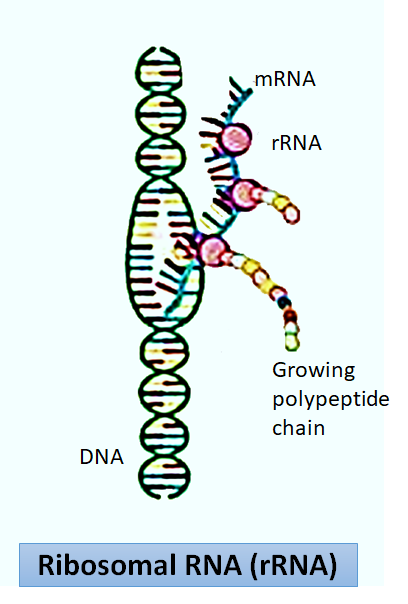Answer
334.5k+ views
Hint: This type of RNA is located in the cytoplasm of a cell that is the RNA component of the ribosome and is essential for protein synthesis in all living organisms.
Complete answer:
Ribosomal ribonucleic acid (rRNA) is the most abundant type of RNA. It constitutes the material inside the ribosome and directly helps in the translation of mRNA into proteins. Based on the sedimentation coefficient, ribosomes are of two types- 70S ribosomes made of 50S and 30S submits, and 80s ribosomes. Prokaryotic cells are of the first type and eukaryotic cells are of the second type. Ribosomes of prokaryotic cells are around 20 nanometres or 200 angstroms in diameter and are composed of 65% rRNA and 35% proteins of ribosomes whereas eukaryotic ribosomes are between 25 and 30 nanometres.
Messenger RNA (mRNA) carries genetic information from the nucleus to the cytoplasm of a cell and is created when the DNA helix is copied in the first step for making proteins. It has the genetic code from DNA that is in a form that can be read and used to make proteins.
The transfer RNA or tRNA brings or transfers amino acids to the ribosome as the formation of any protein requires the assembly of a chain of amino acids. These amino acids can be joined together to make polypeptides and proteins.

So, the correct answer is ‘rRNA’.
Note: A polymeric molecule essential in various biological roles in coding, decoding, regulation, and expression of genes is known as Ribonucleic acid or RNA and it is single-stranded. In the RNA strand, each sugar is attached to one of four bases-adenine (A), uracil (U), cytosine (C), or guanine (G), and has a backbone made of alternating ribose and phosphate groups.
Complete answer:
Ribosomal ribonucleic acid (rRNA) is the most abundant type of RNA. It constitutes the material inside the ribosome and directly helps in the translation of mRNA into proteins. Based on the sedimentation coefficient, ribosomes are of two types- 70S ribosomes made of 50S and 30S submits, and 80s ribosomes. Prokaryotic cells are of the first type and eukaryotic cells are of the second type. Ribosomes of prokaryotic cells are around 20 nanometres or 200 angstroms in diameter and are composed of 65% rRNA and 35% proteins of ribosomes whereas eukaryotic ribosomes are between 25 and 30 nanometres.
Messenger RNA (mRNA) carries genetic information from the nucleus to the cytoplasm of a cell and is created when the DNA helix is copied in the first step for making proteins. It has the genetic code from DNA that is in a form that can be read and used to make proteins.
The transfer RNA or tRNA brings or transfers amino acids to the ribosome as the formation of any protein requires the assembly of a chain of amino acids. These amino acids can be joined together to make polypeptides and proteins.

So, the correct answer is ‘rRNA’.
Note: A polymeric molecule essential in various biological roles in coding, decoding, regulation, and expression of genes is known as Ribonucleic acid or RNA and it is single-stranded. In the RNA strand, each sugar is attached to one of four bases-adenine (A), uracil (U), cytosine (C), or guanine (G), and has a backbone made of alternating ribose and phosphate groups.
Recently Updated Pages
How do you arrange NH4 + BF3 H2O C2H2 in increasing class 11 chemistry CBSE

Is H mCT and q mCT the same thing If so which is more class 11 chemistry CBSE

What are the possible quantum number for the last outermost class 11 chemistry CBSE

Is C2 paramagnetic or diamagnetic class 11 chemistry CBSE

What happens when entropy reaches maximum class 11 chemistry JEE_Main

Calculate the volume occupied by 88 gram of CO2 at class 11 chemistry CBSE

Trending doubts
Difference between Prokaryotic cell and Eukaryotic class 11 biology CBSE

Fill the blanks with the suitable prepositions 1 The class 9 english CBSE

Write an application to the principal requesting five class 10 english CBSE

Difference Between Plant Cell and Animal Cell

a Tabulate the differences in the characteristics of class 12 chemistry CBSE

Change the following sentences into negative and interrogative class 10 english CBSE

What organs are located on the left side of your body class 11 biology CBSE

Discuss what these phrases mean to you A a yellow wood class 9 english CBSE

List some examples of Rabi and Kharif crops class 8 biology CBSE



